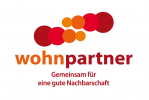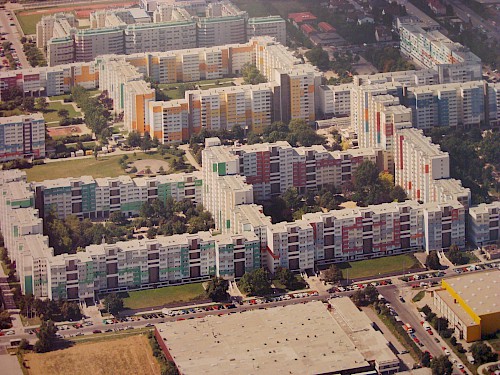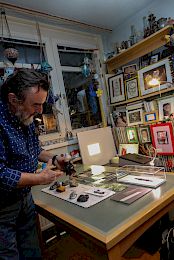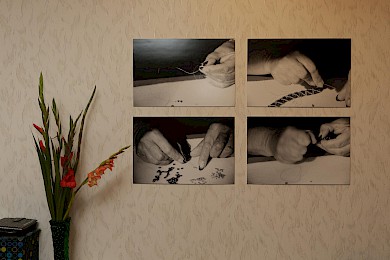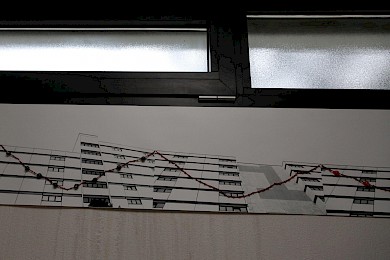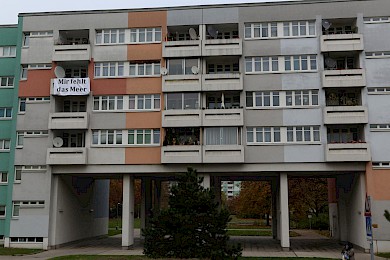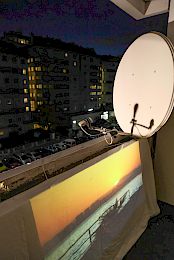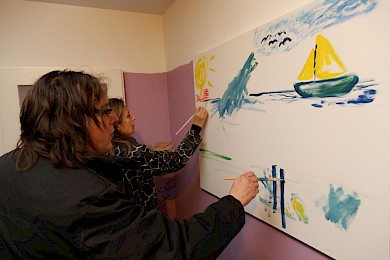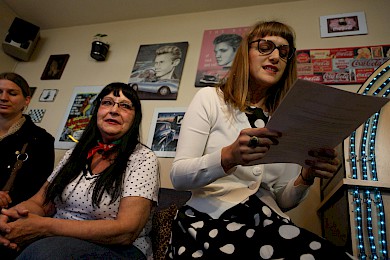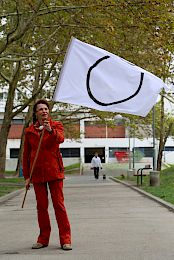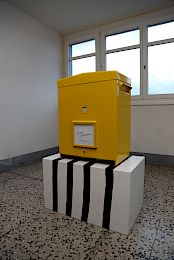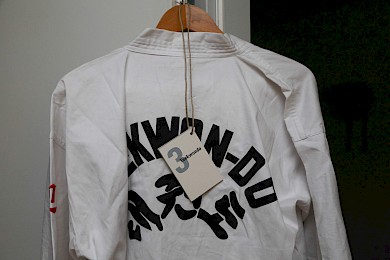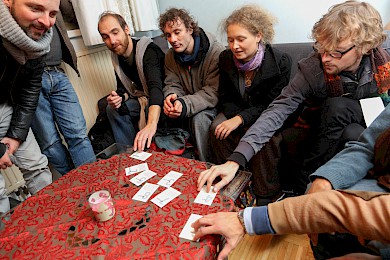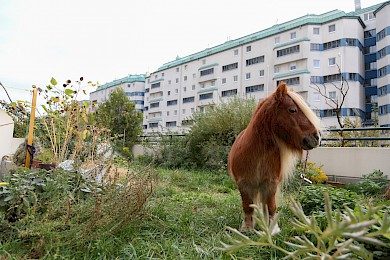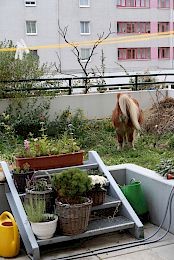The broadly understood term “informal knowledge production/ transfer” served as a guideline for the project Kunstgastgeber Gemeindebau (Municipal Tenement Complexes as Hosts for Art) in 2013. The notion of “sharing knowledge/ wishing to be capable” is based beside longings on the individual curiosity to reach a certain goal, to learn a certain ability/capacity and/ or to impart it. This concerned the participating artists as well as the participating residents.
In order to realize a version of this “sharing abilities/wishing to know”, artists and tenants supported each other, inspired by their own wishes and capacities and those of their counterpart. No matter whether realistically realizable or not — the way here really was the goal.
Based on these questions, a pool of informal knowledge arose, an exchange of inspirations, capacities and the most various “un-/imaginabilities” — but above all a dynamic between one’s own “wishing to be capable” and “being able to” and that of the other.
Text: Gerald Straub
Alfredo Barsuglia as a guest of Samim Sismanoglu
Samim Sismanoglu studied archaeology, ethnology and anthropology. Various depictions and rocklike objects were placed on the table. One of the pieces had a special status, presented in a showcase and labeled “Iron meteorite dagger blade, 3100 BC, Empire of the Hittites, replica, Vienna Donaustadt, 2013.” Samim Sismanoglu told the visitors how iron smelting had once begun. He talked about earlier weapons made from meteorites, and about the dagger of Tutankhamun. At the same time Alfredo Barsuglia drew a diagram of a modern blast furnace on a piece of paper stuck on the balcony door. So all kinds of knowledge transfer came together: graph, photographic material, text, spoken language and presentation objects. To the same degree the past and the present as well as the scientific and the imaginary, reality and fiction interlaced. Thus the “iron meteorite dagger blade” was really “only” an archaeological fantasy, a sensational find that had never existed in this way.
Carla Bobadilla as a guest of Emma Schuh
Among Emma Schuh’s hobbies is the knotting of strings of beads, her apartment is her studio. It was obvious to combine the host’s handicraft and Carla Bodadilla’s photographic practice into an artistic joint work. So a four-part photo work thematized the technical process. The second part of the work was located in the semi-public gangway in front of the ground-floor apartment: the artist had assembled five partial views taken as low-angle shots of the residential block into a long facade panorama. Five slightly different, predominantly red pearl necklaces were ascribed to them.
Pablo Chiereghin as a guest of Nesrin Ay
Both Nesrin Ay and the artist Pablo Chiereghin have memories of the sea. “I miss the sea.” This project reversed this personal concession to the outside: as a banner that occupies the whole balustrade. But what would happen if in a city like Vienna everyone were to convey what they missed to the outside world in a similar way? It would be eminently political. So while outside the sentence was thus addressed to the exterior world, inside the apartment it was picture and sound that evoked the non-existent. A blank canvas was hung on the living-room wall, and brushes, paints and palette were ready. Those present were asked to paint a picture, which was to remain in the apartment for the family. For most of those painting, the sea is “only” a holiday destination. They painted it for Nesrin Ay, who knows the sea from concrete experience, as part of her lost homeland.
Fanni Futterknecht as a guest of Agnes Wohlrab
Who was the artist, who was the host? Fanni Futterknecht slipped into the role of Agnes: “As a child I always wanted to have a petticoat. But I never got one,” said Fanni/ Agnes and talked about the heroes of her childhood, of rock ’n’ roll and of the things she collected over the years. “I have looked after the old radio well, because I very much cling to it. And if it rains, it sometimes softly plays music.” And from somewhere in the apartment music could be heard; it became louder and eventually it stood in the room in person: Elvis-interpreter Ron Glaser was playing the guitar — You Were Always on My Mind. After the song had faded away, the host now explained how dancing had become important again through her daughter. The visitors should also participate now and so Agnes Wohlrab gave an instant-dance course and taught them the basics of rock ’n’ roll steps.
Noah Holtwiesche as a guest of Brigitte Endl
A crystal vase without flowers on the table — or maybe there are some? Flowers in remembrance of earlier journeys: holiday photos on white paper flags, circular and framed in black. The pictures showed exotic, non-European places of the host’s special journeys. Those present selected a flag — some kind of a magic ritual, in order to conjure up Brigitte Endl. She appeared, introduced herself, told flag after flag stories about her journeys — and left the room. Noah Holtwiesche said thanks for the attention. The visitors should keep their eyes about them outside … There stood Brigitte Endl with a large white flag in her hands, on it a black ring like a frame. Unlike in the apartment, this frame was empty. The picture that could fill the circle did not yet exist. Or exactly at this moment it was on its way to fulfill itself in the Rennbahn estate.
Isabella Kohlhuber as a guest of Helga and Reinhold Kaufmann
“Paradises of the animals” — a “play in one act”: the Kaufmanns’ apartment became a stage, their furniture became scenery and Helga and Reinhold Kaufmann became actors of themselves. The Kaufmann couple sat at the table, on which a cake was placed for the guests. Reinhold Kaufmann embroidered, his wife leafed through a travel brochure, accompanied by a collage of sound tracks from nature and animal documentaries. The artist commented on the situation: the Kaufmanns had been to Tunisia several times and would also like to get to know sub-Saharan countries. But what sort of a reality did the visitors experience here? The common image of Africa oscillates between arrogance and bad conscience, between “Out of Africa” and “Heart of Darkness,” between admiration and horror. What should prevent myself to indulge in my "Africa", in order not to be here, not now, not "myself"?
Michikazu Matsune as a guest of Jadwiga Guirguis
Postcards hung at a living room wall showing various motifs from the apartment. As to their colors and design, they took on the general character of the apartment and at the same time they had something enraptured, impersonal. Views out of windows were among them as well as detail shots, a dreamcatcher or the control panel of a game console. The rear showed the writing, as handwritten, “Warm greetings from the Rennbahnweg.” The guests selected a card and noted a recipient of their choice. Stamps could be purchased and the stamped cards could be thrown into an original post-office-yellow letterbox, which was positioned in the gangway in front of the flat — staged like a sculpture, but all together still a “letter box”: at the end of the project, it was emptied and the cards set off.
Michikazu Matsune as a guest of Saša Romanović
This artwork is a present of the artist — to whom? It is inside a sealed box. On the box, the artist’s instruction is written: “Please open in 2113!” Not knowing what is inside a gift package before it is really opened is part of the ritual of gift giving. To have no chance of ever experiencing it, because it may only be unpacked in 100 years’ time and thus transcends one’s whole lifetime and also that of the children and maybe the grandchildren, is an impertinence, at least mentally. Opening it too early would destroy the artwork — materially the box and immaterially through ignoring the instructions. The work will thus be fulfilled only in 2113. The addressee is unknown. Only the accompanying letter is known: it starts “Dear opener of this present.” It speaks of the Romanović family in the past: they “lived in Rennbahnweg 27.”
Stefan Röhrle as a guest of Osman Yildirim
Osman Yildirim stands in the room, his short biography is read aloud: birth in Stuttgart, at the age of five years return to the family in Turkey, at 18 arrival in Vienna, marriage to an Austrian, three daughters. The Kurd works as street cleaner employed by the Municipal Department 48. Important key dates, but not more than a scaffold. What else is there between the bars? A quiz brought it to light: eight cards laid on the living-room table that all described Osman’s supposed occupations or preferences. The visitors read them aloud one after the other. The apartment contained things matching the eight statements about Osman, resembling evidence. But what was true, what was false? His occupation with Nietzsche? Taekwondo, shooting or choral singing? Pointers for insights into Osman’s personality, in preferences or maggots. Who is the host in the first place?
Maruša Sagadin as a guest of Horst Staudinger
Horst Staudinger is locksmith and had to deal with the artist Maruša Sagadin: the common artwork was an interlocking system for an observation tower designed on the computer by the host. It consisted of similar individual parts that were hung into a central support. The necessary metal elements were produced in a specialist enterprise. The tower was positioned on a pedestal and was staged as aesthetic object, for example through the formation of shades at the wall. Nevertheless, its model character remained present: platforms jutting out from the sides are provided to pause and enjoy the view. Two painted wooden figures exemplify the measure — in realized form, the tower would be 8.5 meters high. At its base, a coffee machine enriches the overall experience: a tower for everybody invites to a change in perspective of a totally physical kind — to a view of the world from above.
Nicole Six and Paul Petritsch as guests of Verena Leitner
From the apartment one entered a spacious terrace with a lot of green: a broad strip of grass, bushes and sunflowers. Right in the middle stood an animal that was hardly to be expected — a pony — as if it was at home here. It was spectacular, because it was simply there. The poetic effect was immediate and at first needed no deciphering. But in this context, more than an act of enchantment was at stake — the project rather focused on what ideas this act might trigger. So something “crazy” happened, a seemingly impossible combination of elements transformed into a “possible situation,” as Paul Petritsch said. And this possibility again criticized the living conditions against the background of which many things often seem to be impossible.
Location
Rennbahnweg 27, 1220 Vienna
Gallery
Further Information
Artists
Alfredo Barsuglia
*1980 in Graz (AT), lives and works in Vienna
alfredobarsuglia.com
Carla Bobadilla
*1976 in Valparaíso (CL), lives and works in Vienna
carlabobadilla.at
Pablo Chiereghin
*1977 in Adria (IT), lives and works in Vienna
pablochiereghin.com
Fanni Futterknecht
*1979 in Wien, lives and works in Vienna
fannifutterknecht.com
Noah Holtwiesche
*1972 in Wyk auf Föhr (DE), lives and works in Vienna
pan-vienna.at
Isabella Kohlhuber
*1982 in Bad Ischl (AT), lives and works in Vienna
isabella-kohlhuber.com
Michikazu Matsune
*1973 in Kobe (JP), lives and works in Vienna
michikazumatsune.info
Stefan Röhrle
*1974 in München / Munich (DE), lives and works in Vienna
stefanroehrle.com
Maruša Sagadin
*1978 in Ljubljana (SI), lives and works in Vienna
marusa.sagadin.at
Nicole Six
*1971 in Vöcklabruck (AT), lives and works in Vienna
Paul Petritsch
*1968 in Friesach (AT), lives and works in Vienna
six-petritsch.com
Curator
Gerald Straub
Film documentation
Michael Gartner
Time Period
October 16 to 30, 2013
Education - Events
- Opening Wednesday, October 16, 2013 / at 05:00 PM
- Guided tours October 18 to 30, 2013
Education - Printed matters
Press
Cooperation partner/s
